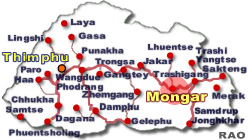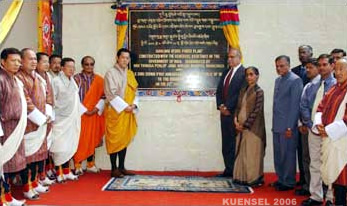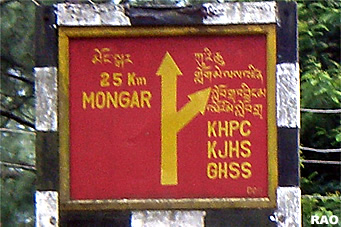 |
Bhutan Economy: Hydroelectric Power |
|
 |
Bhutan
Information |
|
|
 |
|
Kurichhu
Hydroelectric Project inaugurated
|
 |
 |
| It
was a significant event, not just for the eastern dzongkhags, but for the
entire nation. In a special ceremony attended by a large gathering of Bhutanese
and Indian dignitaries, local and national elected leaders, and more than
5,000 people His Royal Highness the Crown Prince, Jigme Khesar Namgyel
Wangchuck, and India's ambassador to Bhutan, Mr. Sudhir Vyas, formally
inaugurated the Kurichhu Hydroelectric Project on April 26, 2006. |
|
After
a sacred ceremony to purify all obstacles and the offering of prayers for
the long-term success of the project His Royal Highness and the ambassador
addressed the gathering. This was followed by an entertainment programme
with lunch served to all the people who had gathered for the celebration.
Bhutan and India inaugurate Kurichhu: a symbol of bilateral cooperation
 |
His
Royal Highness said the realisation of the Kurichhu project was a reflection
of the state of wonderful relations between the governments and people
of India and Bhutan, His Majesty the King's affection for the people, Bhutan's
unique people-oriented development philosophy, and Bhutan's achievements
as a nation. |
|
"Kurichhu
holds a special significance for me," said His Royal Highness. "Bhutan's
development philosophy is people-oriented and, at every stage of our progress,
our hope is that the daily lives of the people are improved.
His
Majesty the King felt that this project would, in spite of its smaller
size, have an immediate and direct impact on the lives of the people of
eastern Bhutan. Today we see the wisdom and fruit in His Majesty's vision.
This project was built solely for the welfare of the people - it is truly
a people's project."
"In
the short time since the inception of the Kurichhu project 17,000 families
have seen dramatic changes in their lives and, in a few years, this impact
is going to expand to the people of 10 dzongkhags."
His
Royal Highness added that the Kurichhu project stood as an example of bilateral
cooperation based on intimate understanding, one that would cement the
bond between the people of the two countries for years to come. He expressed
the deep appreciation of the government and people of Bhutan to the government
and people of India for the generous assistance and also commended the
organisations and firms involved in making Kurichhu a success.
His
Royal Highness commended the Bhutanese engineers, experts, civil servants,
and private sector involved in the project. He said that this was an example
of what could be achieved if the people and the government worked together
with commitment. His Royal Highness said it was an example for the young
people of Bhutan to follow and that he was confident that, in their time,
they would build larger and more technologically advanced projects than
those being built today.
A
run-of-a-river scheme on the Kurichhu river in Gyalpoizhing, Mongar, the
Kurichhu project was established on the command of His Majesty the King
to provide electricity to the people of eastern Bhutan and bring about
balanced regional development.
 |
|
The construction of the project started
in 1995 and was completed in 2001. It was commissioned in September 2001,
and began commercial operations a year later.
The
60 MW project was constructed at a cost of Nu. 5,600 million, funded by
the government of India. According to project officials the total domestic
consumption in Bhutan is about eight to nine megawatts while the rest is
exported to India at a cost of Nu. 1.75 per unit. In 2005, Kurichhu sold
power worth Nu. 547.2 million. |
|
Speaking
at the inauguration the Indian ambassador described the project as a model
of healthy inter-dependent cooperation between the two economies for optimum
utilisation of their natural resources and markets. While Bhutan had the
potential to generate clean power India had the potential market and a
plan to add an additional 41,000 MW in the 10th Plan.
"Our
relationship is exemplary," said the ambassador. "And, in our approach
to our bilateral cooperation, we have always sought to ensure that it remains
in consonance with Bhutan's own priorities and chosen path of development.
Kurichhu adds yet another weave to the varied tapestry of our bilateral
cooperation."
The
chairman of the board of directors of the Kurichhu Hydro Power Corporation,
Lyonpo Yeshey Zimba, reminded the large gathering that His Majesty had
initiated the project with the objective of providing electricity to rural
homes and to bring about balanced regional development.
Besides
the six eastern dzongkhags that receive power from Kurichhu the power will
be transmitted to Sarpang and the central region of Zhemgang, Trongsa,
and Bumthang. The minister informed the gathering that the government of
India had agreed to finance the construction of transmission lines from
Tingtibi to Trongsa and Bumthang and the Dewathang-Rangia line in Assam
to export the power.
Meanwhile
the process of connecting Kurichhu to the Chukha and Tala power lines had
already started.
The
people of Mongar said that the Kurichhu project had changed the lives of
the people of eastern dzongkhags. "It has given people new hopes," said
the Saling Gup, Sonam Yeshey, adding that electric appliances even in remote
villages had made chores easier. "Villagers live healthier lives and can
do more work at night."
"I
never imagined that Kurichhu would change the region this much," said chimi
Namgangla who was present when His Majesty announced the establishment
of the project during the Seventh Five Year Plan. "Gyalpoizhing was a malaria-infested
wasteland," he said. "Now it is churning the engines of growth."
Many
people in the gathering said that they viewed Kurichhu, not as a hydropower
project, but a harbinger of economic development in the east. "With balanced
development rural-urban migration would also be stopped," said a businessman.
A student from Drametse said hat they had put away their kerosene lamps
at last and switched on lights to study. "I want to top the national level
examination," he said.
In
remote Thangrong gewog, one of the gewogs yet to be electrified, 310 families
are waiting for the power to reach their villages. "We are waiting for
electricity to carry us into a new world," said Tshewang Rinzin who had
come to the inauguration ceremony because he could not contain his excitement.
He said he had heard that people were already investing in rice cookers
and other household appliances, anticipating the power supply.
This
new world was best described by Gyem Zam of Drametse, which received power
in the first week of April this year: "It is as if the daylight has become
longer and we can do so much more for our work and with our families."
| Contributed
by Ugyen Penjore, Kuensel, Bhutan's national newspaper, 2006 |
 |
| more
information |
 |
|





